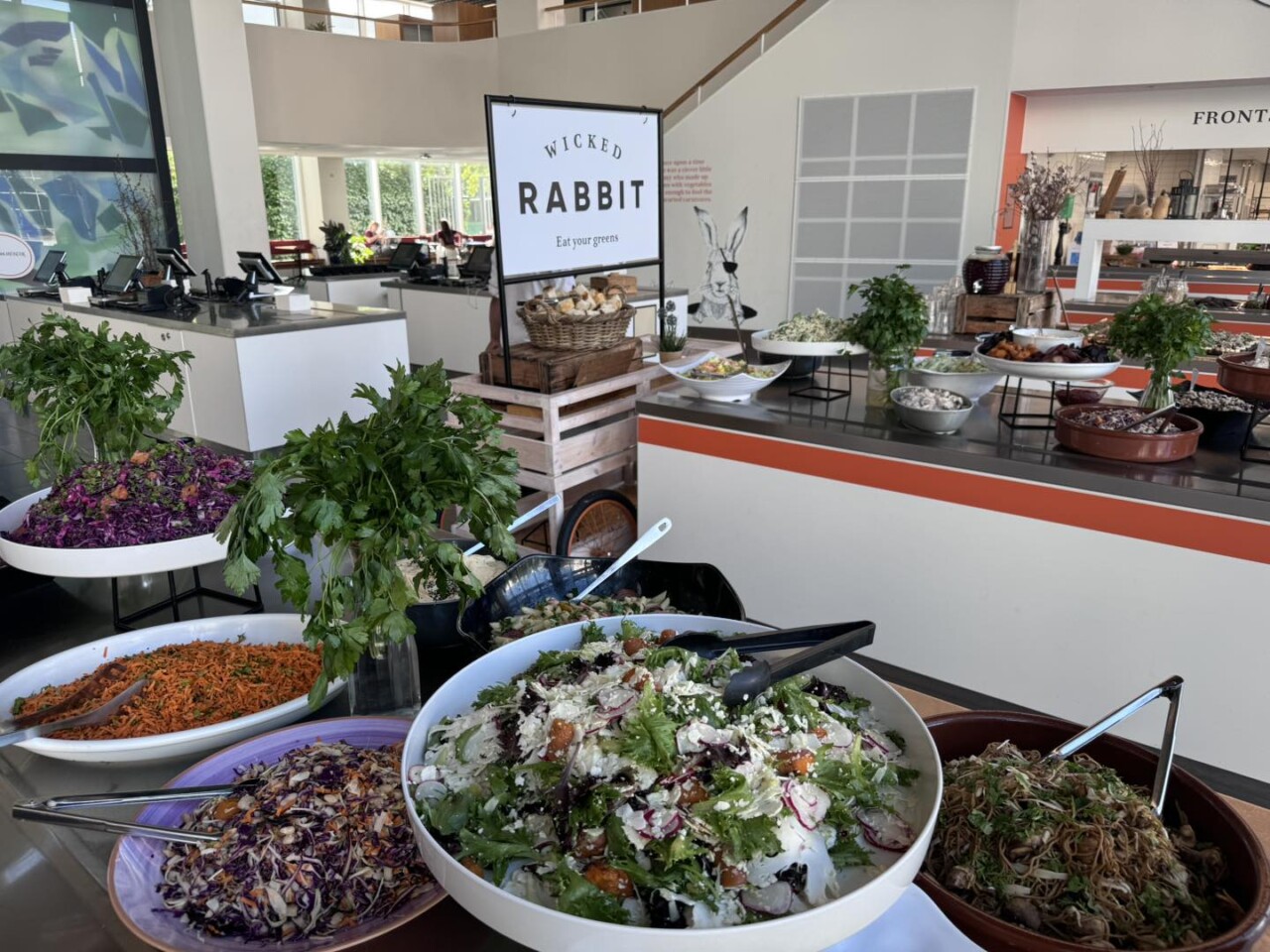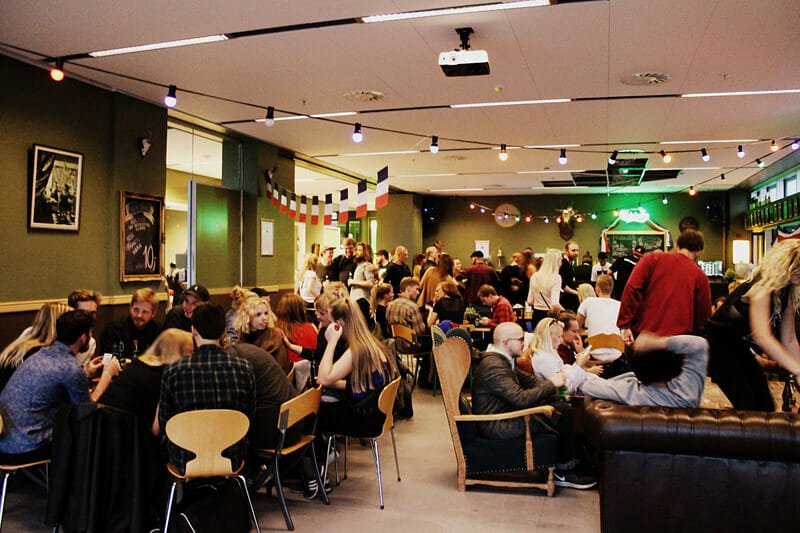Universitetsavisen
Nørregade 10
1165 København K
Tlf: 35 32 28 98 (mon-thurs)
E-mail: uni-avis@adm.ku.dk
—
Campus
Overview — The University of Copenhagen has four campuses. Here is your guide to South Campus. From Friday bars and canteens to hideouts, and everything you need to know for student life.
First things first: No one calls it South Campus. Sure, the university does officially, but students stubbornly and proudly stick to the old name that was officially laid to rest in 2017: KUA [pronounced ‘koo-a’, ed.].
KUA (Københavns Universitet Amager) was originally a brutalist concrete complex — described by author and alumnus Jan Sonnergaard as »Northern Europe’s cheapest, ugliest and most unpleasant institutional building«.
But now, this bastion of the humanities has been torn down and replaced by three sandstone-and-glass buildings (called KUA 1–3). When the theologians, law students, and what was once the Royal School of Library and Information Science (later the Department of Information Studies, now part of the Department of Communication) moved into KUA 3 in 2017, they brought the student population up to a total of 16,000.
It is now the Faculty of Humanities, the Faculty of Law and the Faculty of Theology that are housed here in the no frills, traditionally-working-class-but-now-gentrified, neighbourhood of Amager. And the Faculty of Social Sciences will soon be there also, as they relocate from their historic base in the city centre.
The square Karen Blixen’s Plads connects the three university buildings — and the faculties — with wifi coverage, outdoor power outlets (!) and covered bicycle sheds that look like Death Stars from the film Star Wars.
How to find your way around: Every stairwell at South Campus is painted in an — often blinding — colour that runs all the way up through the building. If that’s your thing, you can also navigate using the room numbering system. If you’ve got some, say, ‘post-tonal analysis’ in room 16.4.74, that means building 16 (bright yellow), 4th floor, room 74. Room 74 isn’t necessarily next to room 73 — but you’ll figure it out. Just like you’ll come to learn that KUA 1 houses buildings 21–27 (except 26, which doesn’t exist), while buildings 10–16 are in KUA 2 and buildings 4–9 are in KUA 3 (1, 2 and 3 don’t exist either). Simple, right? And you don’t even need to worry about finding buildings 21, 22 and 27, because they have been temporarily closed due to mould.
Student counselling: Each department has its own guidance office. If your computer acts up or your OneNote app crashes, help is close by at South Campus, where KU-IT is ready for you in KUA 2. You’ll also need to make your way to KUA to pick up your brand new ID card, which (sometimes) only gives you access to locked campus doors — but more importantly, the UCPH parties you want to attend.
South Campus
Home to around 15,000 students across three faculties and over 100 study programmes
Reading rooms: There is plenty of study space at the departments — that is, those in KUA 2 and 3, because it was precisely the lack of seating in KUA 1 that had the builders factoring in reading space in their construction plans. You’ll also find quiet areas at the departmental libraries (except for the Department of Arts and Cultural Studies library in building 16, which is unfortunately located right next to the piano practice rooms) — and, of course, at the main library KUB South Campus.
READ ALSO: Students are juggling Zoom classes, exams — and mould risk
Speaking of fancy new builds in KUA 3, the juridisk videnscenter at the Faculty of Law, with its large atrium, is excellent for both solo and group study. If you need peace and quiet, a good reading room is hidden behind the atrium’s iconic giant staircase.
Canteens: The large canteen in KUA 1 serves hot meals, open sandwiches and salads. The vegetarian Wicked Rabbit in KUA 2 has an excellent selection of greens — and meat lovers will enjoy the law faculty’s canteen kitchen in KUA 3. If you go for the buffet, it can get a bit pricey, as the two main canteens charge by weight. A pro tip among seasoned KUA-goers is to buy food at Wicked Rabbit after 2 pm, when prices are halved. The coffee bar Mødestedet in KUA 2, part of the Hava Java chain (also found in KUA 1 and 3), offers sandwiches, chia porridge, and salad bowls. Early risers may be tempted by the scent of homemade waffles with crispy bacon (or skyr and berries) from the Folkekøkkenet in KUA 2. You might also be tempted by »the biggest cheese bun I’ve ever had,« as one student described it, for just DKK 15 — a price that few Copenhagen bakeries can compete with.
READ ALSO: Offbeat locations at the University of Copenhagen
Coffee: All canteens offer reasonably priced filter coffee — and more expensive, fancier varieties at Mødestedet — but the cheapest cup is usually found at your local café or Friday bar, where the proceeds even go back to students. Rumour has it the cheapest brew is at the Department of Nordic Studies and Linguistics coffee bar, where a filter coffee costs just 4 kroner if you bring your own cup.
Friday bars: Congratulations, you’ve arrived in Friday bar heaven. Every department at South Campus has its own bar or café — the beating heart of student life and your new home (see the full list of student clubs at UCPH here). The newcomers from the city centre have settled in nicely: Jurabar finally has enough room for the masses, and Teobar has brought its good vibes with it (and excellent drinks menu) from its old basement bar in the inner-city Købmagergade out to the glass cage which is South Campus.
Once you’ve found your own Friday bar, you can set off on the time-honoured tradition of the KUA crawl, where you get lost in the South Campus corridors in search of neighbouring Friday bars. May we suggest the cosy Café Helga at the SAXO Institute and Roland Bar at the Department of Arts and Cultural Studies — both known for their laid-back vibes and late-night dancing. Due to KUA’s closing rules, the lights go on and the party ends at midnight. But you can still ride the high of your new uni life and continue the night at Katten or Kommunen on the central CSS campus in the city centre, home to the Faculty of Social Sciences, where the dance floor is guaranteed to be buzzing until sunrise — or head to A-vej, which isn’t on Akacievej as the name suggests, but on Dyrlægevej on Frederiksberg Campus. Close enough.
Dress code: The scruffy humanities student of yesteryear — dark brown turtleneck and all — is back in fashion. But style varies widely, with Theology leaning casual, and Law leaning catwalk.
SIGN UP FOR THE UNIVERSITY POST NEWSLETTER HERE
Hideouts: At KUA there are many high-backed sofas facing each other, shutting out the world. It’s wonderfully peaceful on the fourth floor at the Faculty of Law, and the rooftop terraces between buildings can offer a moment of quiet outside peak hours — just like the canal by KUA 1, where you shouldn’t deny yourself a trip to Ismageriet. Not many campuses can boast homemade Snickers-style ice cream with burnt caramel and crystallised nut crumble (or whatever today’s flavour is).
Last year, more than one unfortunate person managed to ‘hide’ accidentally in one of the cold canals. We don’t recommend it.
Smoking: After controversy over smoking on the rooftop terraces (not allowed!) and at the entrance to KUA 3 (also not allowed!), the cigarette crowd has been relegated to street-level outdoor areas. But you can sit with a clear conscience on one of the yellow hills overlooking the square, cigarette in one hand, Judith Butler in the other.
Online: Join the KUA Facebook group — where people post job ads, lost and founds, etc.
Look forward to: MiGP, KUA’s very own Eurovision Song Contest, organised every year by the Musicology department and held in the Festival Hall in KUA 2. If you miss this event, you can always catch one of KUA’s fantastic football matches instead — they might lose 8–0 on the pitch, but they win hands down in the stands, where the cheering section is all song and music.
The first version of this article was written in Danish and published in 2018. It has been continually updated, with the latest Danish update on 14 August 2025. It has been translated into English and post-edited by Mike Young.




